The Economics and Statistics Division maintains archives of previous publications for accountability purposes, but makes no updates to keep these documents current with the latest data revisions from Statistics Canada. As a result, information in older documents may not be accurate. Please exercise caution when referring to older documents. For the latest information and historical data, please contact the individual listed to the right.
<--- Return to Archive
For additional information relating to this article, please contact:
April 25, 2022BUSINESS OPENING AND CLOSING, JANUARY 2022 Statistics Canada released updated data on monthly business openings and closures for January 2022. The data is not adjusted for seasonal patterns.
A business will be classified as 'opening' if it had no employment in the previous month and then has employment in the next month. A business is 'closing' if it had employment in the previous month and no employment in the current month. For opening and closing, the reason could be a permanent change (i.e. business exit) or temporary for reasons such as seasonal operations, capital maintenance, restructuring or the COVID-19 situation. Continuing business are those that had employment in both the current and previous month. Active businesses are the sum of continuing and opening business in the current month.
With the emergence of the Omicron variant at the end of 2021, many provinces tightened restrictions. However this does not appear to have affected the number of overall active businesses as there were increases in every province in January 2022 when many of these additional restrictions were in place.

The number of active businesses in Nova Scotia increased by 0.4% from December 2021 to January 2022 (20,301 active businesses). Nationally, active businesses were up 0.7%. Every province reported more active businesses in January 2022 than in December 2021, with Ontario and Alberta reporting the largest increases. Saskatchewan, New Brunswick and Newfoundland and Labrador reported the slowest gains.
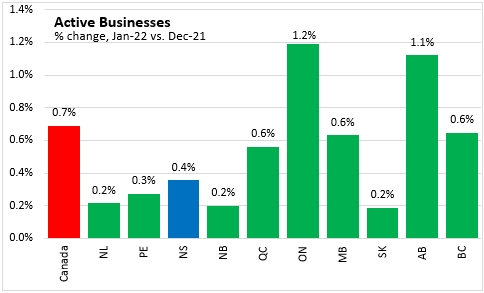
Compared with February 2020, the number of active businesses was up 1.5% for Nova Scotia in January 2022. Nationally, active businesses were 1.6% higher compared to February 2020. Seven provinces reported more active businesses, with British Columbia reporting the largest gain. Newfoundland and Labrador saw the largest decline in active business comparing January 2022 with February 2020.
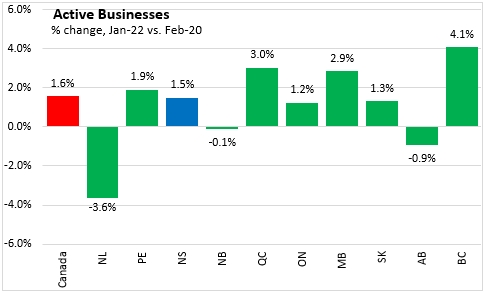
The number of active businesses in Halifax was up 3.9% from February 2020 to January 2022. Among cities (Census Metropolitan Areas), only four report fewer active businesses from February 2020 to January 2022: St. John's, Saguenay. Sudbury and Thunder Bay. The cities with the largest rises in the number of active businesses were Kelowna, Oshawa and Sherbrooke.
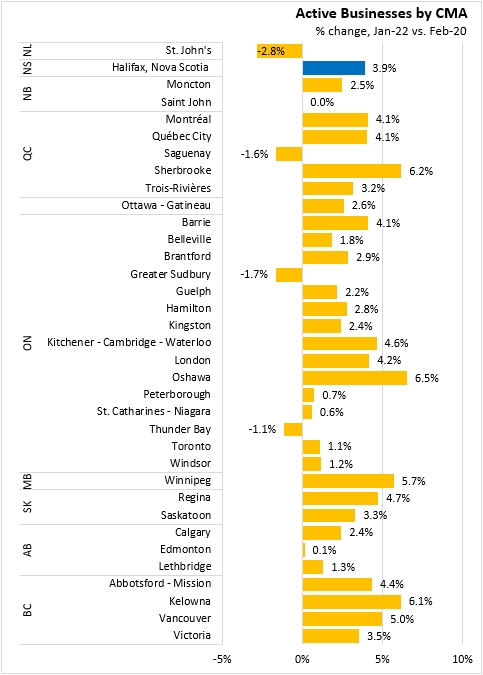
The rate at which business either opened, continued or closed can be examined to see how the number of active businesses has changed. The calculation for the opening, continuing and closure rates are based on the number of active businesses in the previous month.
Most businesses continue operating each month. At the height of COVID-19 related restrictions, the share of businesses that continued to operate from one month to the next fell to 88.8% in Nova Scotia, down from 95.8% in February 2020. National continuing rates fell from 95.8% in February to 89.5% in April 2020. In January 2022, Nova Scotia's business continuing rate rebounded to 96.1% while the national rate grew to 96.3%.
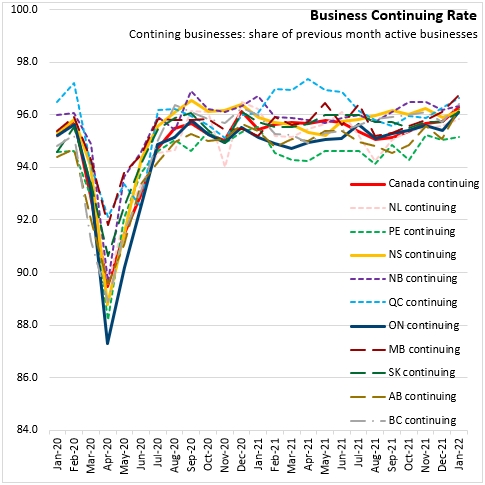
Nova Scotia’s business opening rate was 4.1% in February 2020 and declined to 3.5% April 2020. Business opening rates increased sharply in summer of 2020 and remained elevated through the latter half of 2020 and most of 2021. Nova Scotia's business opening rate was 4.5% as of January 2022 (4.9% nationally).
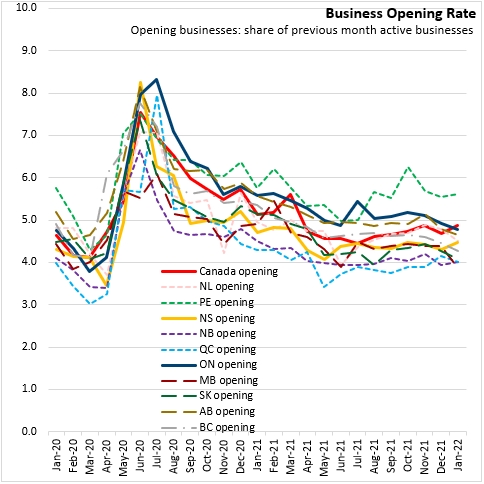
The rate of business closures in Nova Scotia was 4.0% in February 2020. Business closing rate increased sharply during the first two months of the pandemic in 2020 but fell in the summer of 2020. Nova Scotia's business closing rate fell to 4.0% in January 2022 (3.8% nationally).
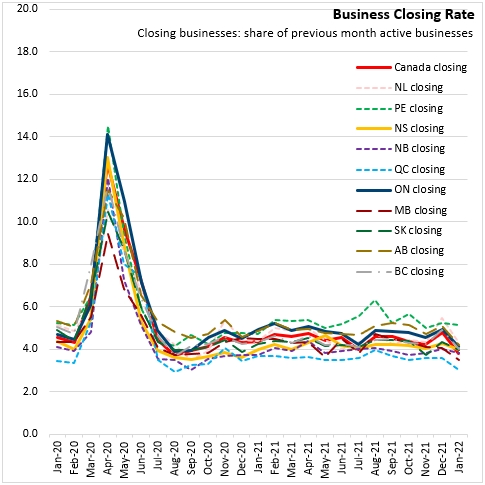
Compared with the February 2020 (pre-pandemic) benchmark, the number of active Nova Scotia businesses in January 2022 was lower in mining/oil/gas (a small number to start with), wholesale trade, retail trade and personal/repair services. From February 2020 to January 2022, there were notable percentage increases in the number of active businesses in utilities (also starting from a small number), professional/technical services, information/culture, construction, manufacturing, transportation/warehousing, and arts/entertainment/recreation.
Nationally, the number of active businesses was down for many business sector industries, with increases in professional, scientific and technical services, information and cultural industries and construction. The largest declines were reported in mining/oil/gas, personal/repair services, wholesale trade, arts/entertainment/recreation, and accommodation/food services.
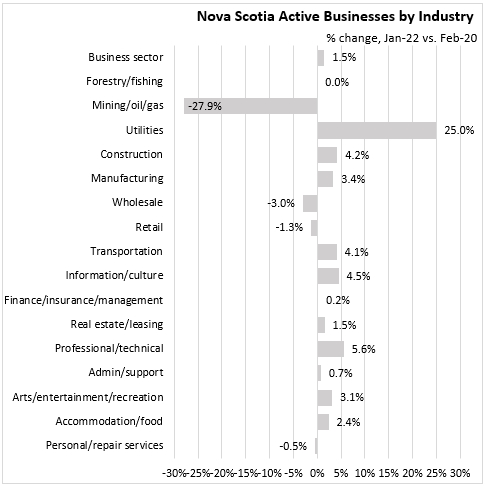
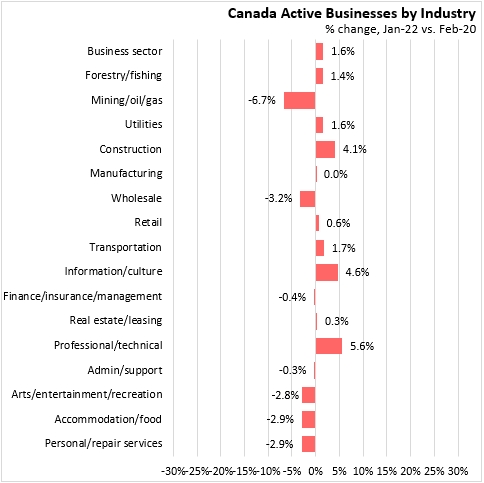
Statistics Canada has broken out specific data for tourism-related industries. This shows that the number of active tourism-related businesses was up 2.3% in Nova Scotia from February 2020 to January 2022. Travel services are now the only tourism-related industry to report lower active businesses compared to before the pandemic in Nova Scotia (transportation unchanged). Nationally the decline was 3.7% with only accommodation reporting a (small) increase.
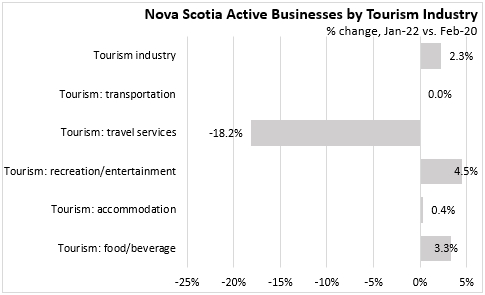
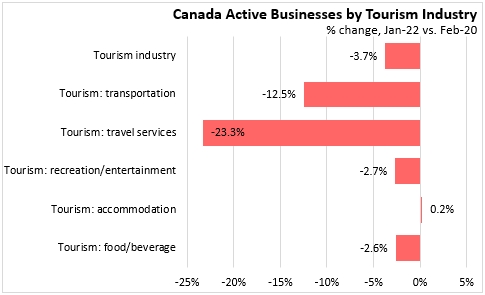
Construction reported the largest increase in the number of businesses from December 2021 to January 2022. Wholesale trade reported the largest decrease.
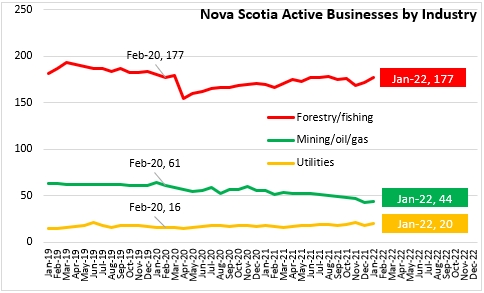
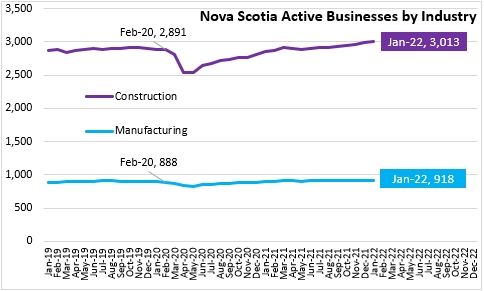
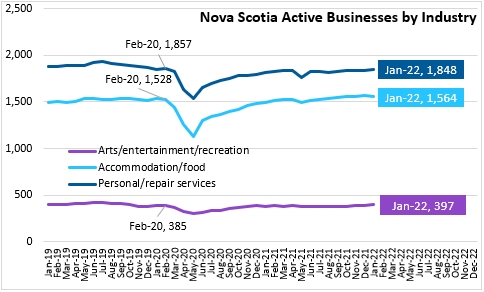
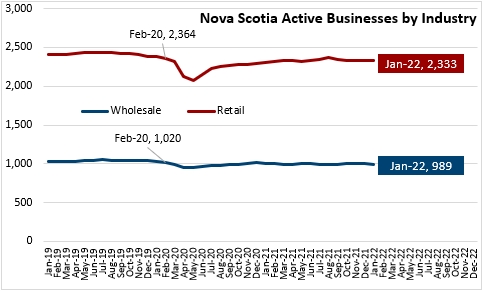
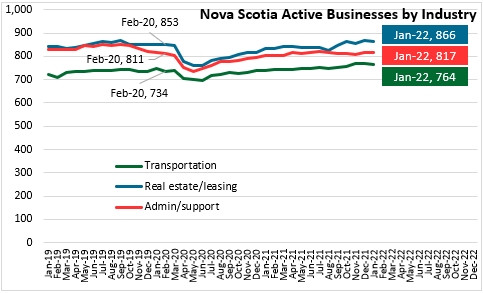
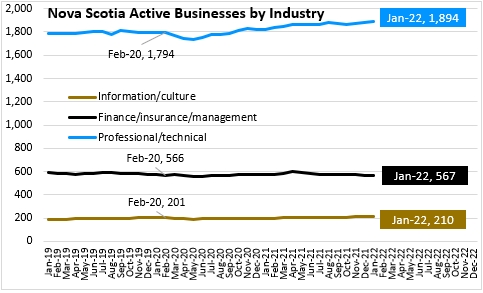
The source data is seasonally adjusted. The data may not aggregate due to firms being classified into multiple industry or geography.
Source: Statistics Canada. Table 33-10-0270-01 Experimental estimates for business openings and closures for Canada, provinces and territories, census metropolitan areas; Methodology: Business Opening and Closing
<--- Return to Archive